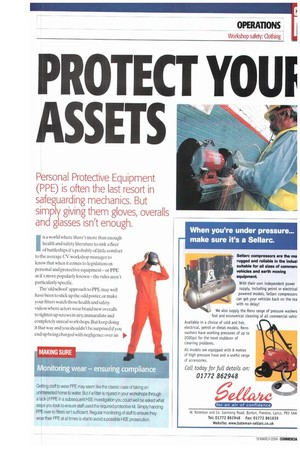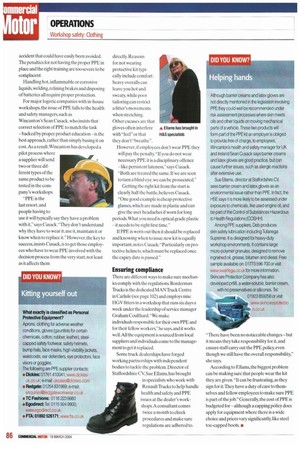PROTECT YOUI ASSETS
Page 85

Page 86

If you've noticed an error in this article please click here to report it so we can fix it.
Personal Protective Equipment (PPE) is often the last resort in safeguarding mechanics. But simply giving them gloves, overalls and glasses isn't enough.
In a world where there's more than enough health and safety literature to sink a fleet of battleships it's probably of little comfort to the average CV workshop manager to know that when it comes to legislation on personal and protective equipment — or PPE as it's more popularly known — the rules aren't particularly specific.
The 'old school' approach to PPE may well have been to stick up the odd poster, or make your fitters watch those health and safety videos where actors wear brand new overalls to tighten up screws in airy, immaculate and completely unreal workshops But keep doing it that way and you shouldn't be surprised if you end up being charged with negligence over an accident that could have easily been avoided. The penalties for not having the proper PPE in place and the right training are too severe to be complacent.
Handling hot, inflammable or corrosive liquids, welding. refining brakes and disposing of batteries all require proper protection.
For major logistic companies with in-house workshops, the issue of PPE falls to the health and safety managers, such as Wincanton's Sean Cusack. who insists that correct selection of PPE to match the task backed by proper product education is the best approach, rather than simply basing it on cost. As a result, Wincanton has developed a pilot process where a supplier will send two or three different types of the same product to be tested in the company's workshops.
"PPE is the last resort. and people having to use it will typically say they have a problem with it," says Cusack."They don't understand why they have to wear it, use it, maintain it or know when to replace it." However, the key to success, insists Cusack,is to get those employees who have to wear PPE involved with the decision process from the very start, not least as it affects them directly. Reasons for not wearing protective kit typically include comfort: heavy overalls can leave you hot and sweaty, while poor tailoring can restrict a fitter's movements when stretching. Other excuses are that gloves often interfere A Ellams has brought in with"feel"or that H&S specialists they don't "breathe".
However, if employees don't wear PPE they will pay the perialty."If you do not wear necessary PPE it is a disciplinary offence like persistent lateness,-says Cusack. "Both are treated the same. ff we are seen to turn a blind eye, we can be prosecuted."
Getting the right kit from the start is clearly half the battle, believes Cusack. "One good example is cheap protective glasses, which are made in plastic and can give the user headaches if worn for long periods. What you need is optical grade plastic it needs to be right first time."
If PPE is worn out then it should be replaced and knowing when to issue new kit is equally important, notes Cusack:"Particularly on protective helmets, which must be replaced once the expiry date is passed."
Ensuring compliance
There are different ways to make sure mechanics comply with the regulations. Borderman Trucks is the dedicated MAN Truck Centre in Carlisle (see page 102) and employs nine HGV fitters in a workshop that runs six days a week under the leadership of service manager Graham Coulthard."We make individuals responsible for their own PPE and for their fellow workers," he says, and ii works well.All the equipment is sourced from local suppliers and individuals come to the management to get it replaced.
Some truck dealerships have forged working partnerships with independent bodies to tackle the problem. Director of Staffordshire CV, Sue Ellams,has brought in specialists who work with Renault Trucks to help handle health and safety and PPE issues at the dealer's workshops.A consultant comes twice a month to check procedures and make sure regulations are adhered to. "There have been no noticeable changesbut it means they take responsibility for it, and ensure staff carry out the PPE policy,even though we still have the overall responsibility," she says.
According to Eilams, the biggest problem can be making sure that people wear the kit they are given. It can be frustrating, as they sign for it.They have a duty of care to themselves and fellow employees to make sure PPE is part of the job." Generally, the cost of PPE is budgeted for although a capping policy does apply for equipment where there is a wide choice and prices vary significantly, like steel toe-capped boots. •








































































































































































































































